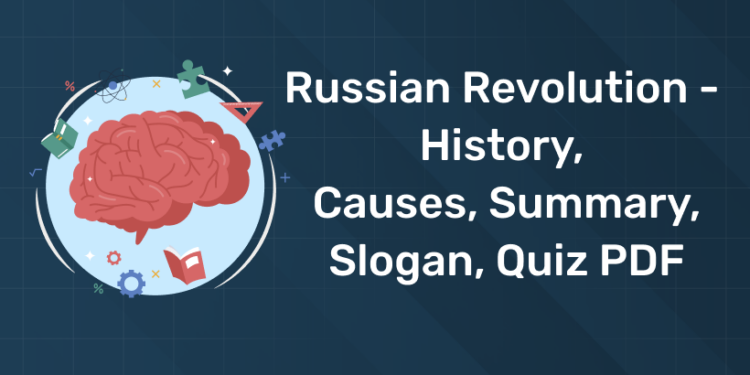Table of Contents
The Russian Revolution was the first successful communist uprising. It marked a major shift in history. Russia changed from an autocratic empire to a socialist state. This revolution inspired socialist ideologies worldwide. This article is about Russian Revolution – History, Causes, Summary, Slogan, Quiz PDF.
Russian Revolution
The Russian Revolution refers to a series of political events in Russia between 1917 and 1923 that led to the dismantling of the Tsarist autocracy and the rise of the Soviet Union.
History of the Russian Revolution
The Russian Revolution of 1917 had two key events. The February Revolution ended Tsar Nicholas II’s rule. A provisional government was then established. The October Revolution, led by Lenin, overthrew this government. This led to the creation of Soviet Russia.
Causes of the Russian Revolution
Political Causes
Tsar Nicholas II’s autocratic rule centralized power, allowing corrupt ministers unchecked influence. Civil freedoms were severely restricted, with harsh measures against dissenters like arrests. A lack of a parliamentary system limited democratic expression and fueled public frustration. These political restrictions created widespread disillusionment among the Russian population.
Suppression by Secret Police
The Tsar employed the secret police, called the Cossacks, to quash dissent. This repression stifled opposition movements and deterred government criticism. Fear of the Cossacks instilled compliance and prevented organized challenges to the regime. These measures aimed to maintain the Tsar’s authority and suppress potential threats.
Absence of a Parliamentary System
Russia lacked a parliamentary system until the Revolution of 1905 led to the State Duma. Political representation was minimal, concentrating power in the monarchy’s hands. This centralized authority marginalized broader societal voices, breeding dissatisfaction with the regime. The absence of democratic processes hindered reforms and worsened social inequalities.
Involvement in World War I
Russia’s entry into World War I in 1914 strained its economy and society. The war exacerbated social tensions and economic hardships, fueling discontent. Military setbacks and shortages intensified public anger and eroded support for the Tsarist government. As opposition grew, revolutionary sentiment spread across society.
Influence of Rasputin
Grigori Rasputin, a mystical advisor, held sway over Tsar Nicholas II and Alexandra Feodorovna. His influence undermined public trust in the monarchy and deepened discontent. Rasputin’s presence symbolized corruption and incompetence, fueling revolutionary fervor. This association contributed to the eventual collapse of the Tsarist regime.
Frequently Asked Questions
Can you summarize the Russian Revolution?
- The Revolution began in February 1917.
- Tsar Nicholas II was overthrown.
- The Bolsheviks seized power in October.
- A communist government was established.
What was a key slogan of the Russian Revolution?
- “Peace, Land, and Bread” was central.
- It promised to end war.
- It aimed to redistribute land.
- It sought to alleviate food shortages.
What were the main events of the Russian Revolution?
- February Revolution in 1917.
- Tsar Nicholas II abdicated.
- October Revolution in 1917.
- Bolsheviks seized power.
What were the long-term impacts of the Russian Revolution?
- Establishment of the Soviet Union.
- Creation of a communist state.
- Profound global geopolitical influence.
- Shaped 20th-century ideological conflicts.
How did the Russian Revolution impact international relations?
Fear among Western powers of communist expansion was sparked by the Revolution, leading to interventions and proxy wars during the Cold War era.













